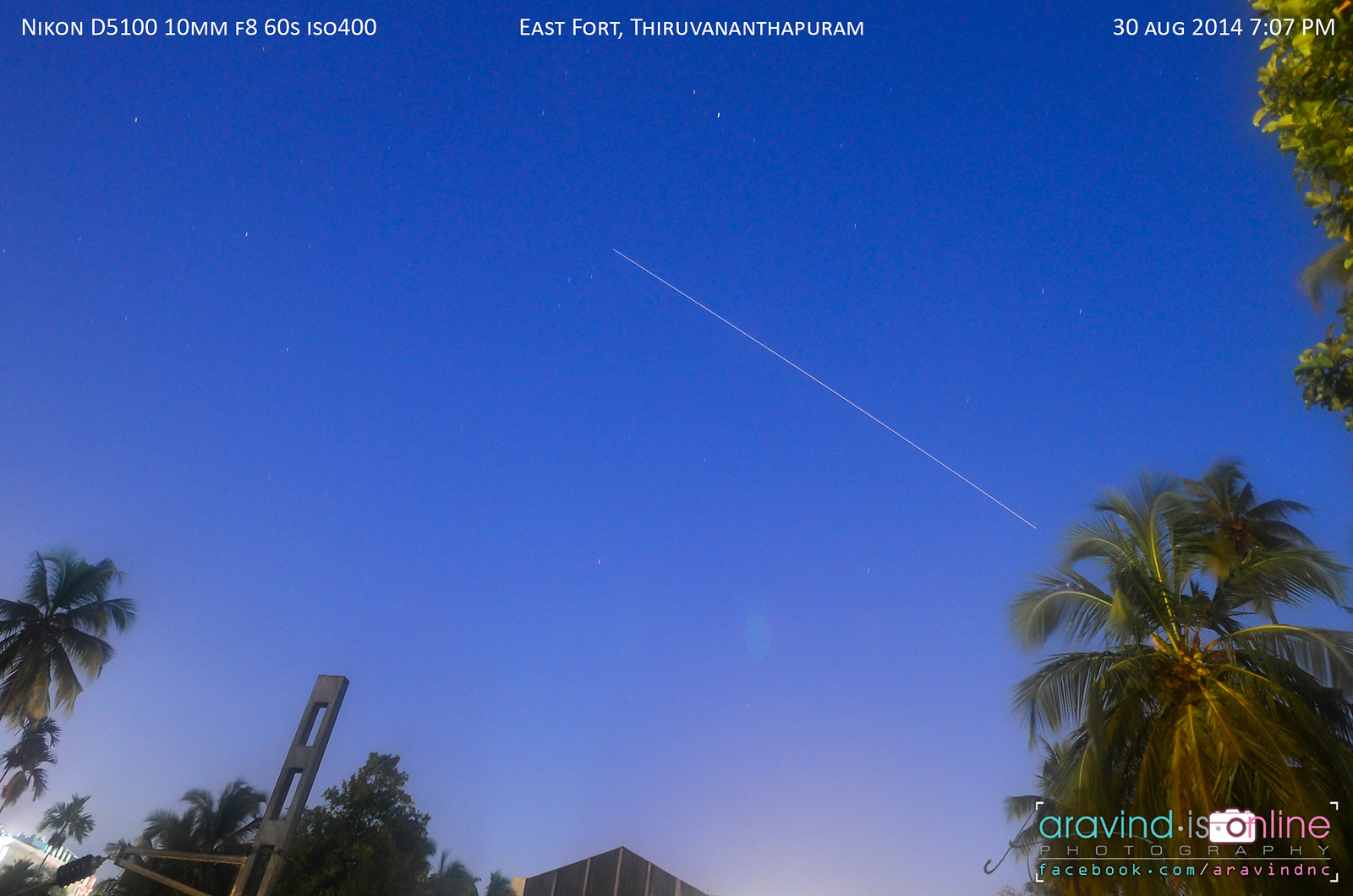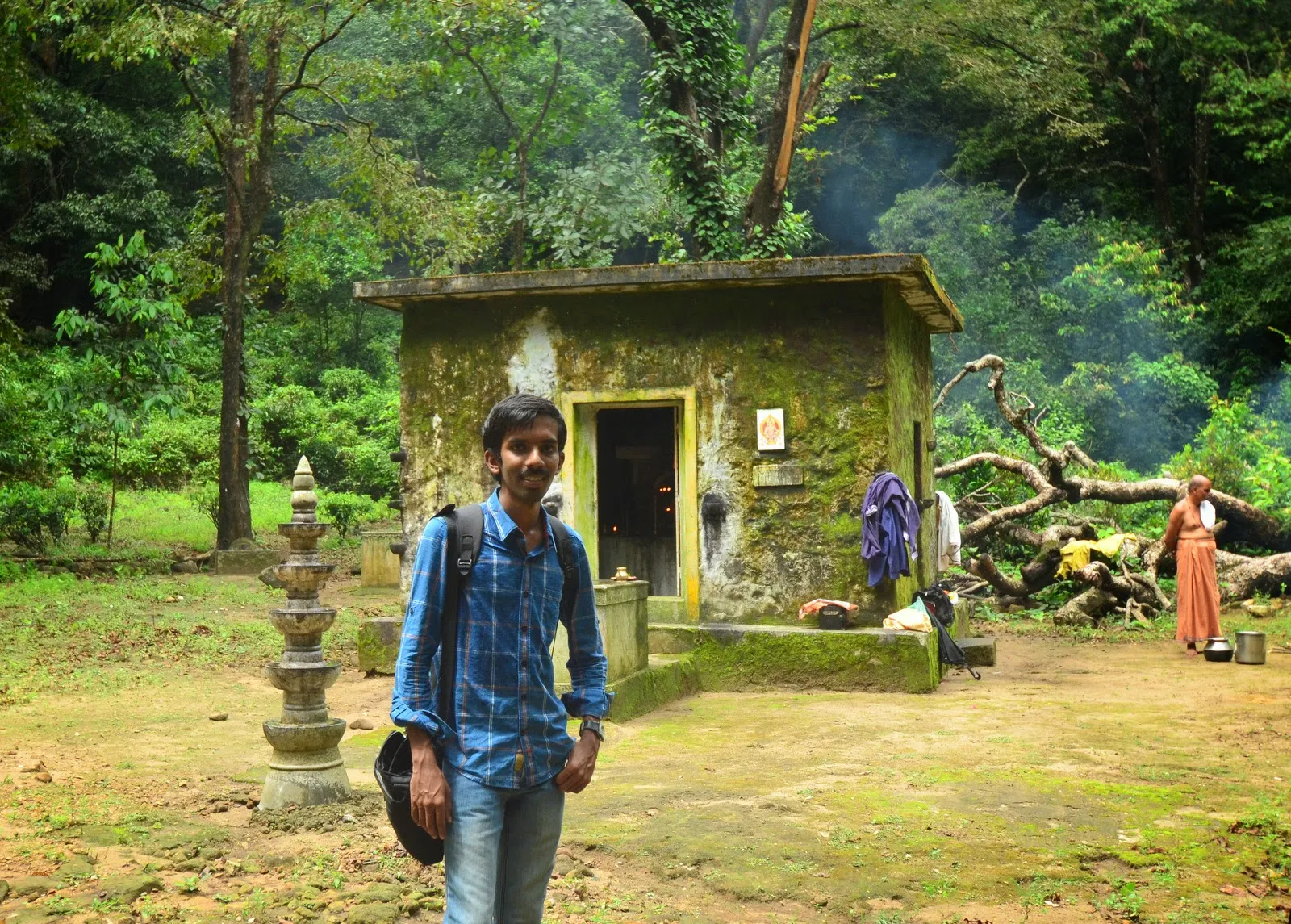Well that was an awesome, adventurous trekk "Mankayam - Brimore -
Ponmudi" with Tree Club. We 18 people started at 9:00am from Mankayam
Checkpost via Nedumangad - Palode route. Then to Brimore estate via car,
reached there at 9:30am and started trekking at 10:00am from Brimore
Estate. There were 2 guards accompanying us. Wow there was too much ups
in the start and of course leeches. Damn! As a precaution we carried
salt water and it helped a lot during the walk. There was 100's
and 1000's of leeches on the way, if we stand still anywhere for
at-least 1sec then the leech will enter our shoes. We saw footprints of
an elephant throughout the way and we feared about its encounter. It was
an adventurous walk through sun and slippery rocks, steep climbs etc.
And I was just about to sit over a snake, later I came to know that it
was a super poisonous snake thanks to my friend Ameer for the perfect alert
timing. After traveling through grass lands, we reached the top of #Ponmudi
at 1:30 AM. Just checked my legs, wow full of leechs, blooding
non-stop. Salt water helped us. Then we had lunch and started the return
trip at 2:30 am. By that time it was total fog, and very poor
visibility and suddenly rain started, just mild rain. The return trip
had 2 options (1) Travel through normal route but time consuming and its
raining (2) Traveling via shortcuts but through the kingdom of leeches
but. We choose option 2 as the raining went a bit heavy and cloudy also
an elephant is somewhere nearby. We went through bushes and steep ups
and downs. The glucose in my hand was very effective than water. Walking
through the bushes, as we walked forward the heights of the bushes is
coming to raise, and finally we end up in the road. Travelled back to
Mankayam falls, had a sighting of the 3 stage waterfalls and then we
returned. It was a pleasure and adventurous trip. Total trek length was
14-16kms in around 7hrs. Hope every body enjoyed the journey. I'm not a
blog writer, I just want to share my experience. Thank you all.
Sunday, October 19, 2014
Tuesday, October 7, 2014
Prestashop - Solving common email related issues
There are some common email related issues in Prestashop. Some of them are when we do registration, forgot password etc they say email has been set, but we may not receive it.
The issue can be due to the below reasons.
- "From" field doesn't match your domain.
- Incompatible additional headers.
Below are solutions to both:
In /tools/swift/Swift/Message.php line #79
Change
$this->setFrom(""); $this->setFrom("youremail@yourdomainname.com");
In /tools/swift/Swift.php after line 370
if (!($has_reply_to = $message->getReplyTo())) $message->setReplyTo($from);
if (!$has_reply_to[0])
$message->setReplyTo($from->getAddress()); Now try sending a contact message....
If it still doesn’t work, make the following change:
In /tools/swift/Swift/Plugin/MailSend.php line # 159
Add
$params = ""; Monday, September 1, 2014
International Space Station (ISS) over Kerala, Thiruvananthapuram, India
Depending on your location on the Earth's surface, a spacecraft's
position in orbit and the time of day, you may be able to see the
International Space Station (ISS) or visiting vehicles as they orbit
about 240 statute miles above the planet. The space station looks like a
fast-moving plane in the sky, but it will be seen as a steady – not
blinking – white pinpoint of light. Typically it will be the brightest
object in the night sky (except for the Moon). It is bright enough that
it can even be seen from the middle of a city!

Interpreting the Data
The text listing is in a column format, a sample of which is shown below:| Satellite |
Local (date/time) |
Duration (min) |
Max Elevation (deg) |
Approach (deg-dir) |
Departure (deg-dir) |
| ISS | Tue Nov 14/06:22 AM | 4 | 66 | 10 above WSW | 31 above NE |
This sighting opportunity is illustrated in the figure below:
Image above: Satellite sighting graphic shows how to locate a satellite during a viewing opportunity. Credit: Richard Czentorycki (RSIS)/NASA.
Viewing Tips
For best results, observers should look in the direction and at the elevation shown in the appearing column at the time listed. Because of the speed of an orbiting vehicle, telescopes are not practical. However, a good pair of field binoculars may reveal some detail of the structural shape of the spacecraft.Saturday, February 22, 2014
Youtube - Add a custom URL to your channel
If
you had or have a traditional YouTube username on your channel, then
you unfortunately can't add a custom URL or change your URL. Your
channel already has a URL associated with your old username, like the
following:
When you create a new YouTube channel using your Google identity, you'll have a default unique URL that looks something like this:http://www.youtube.com/user/USERNAME
http://www.youtube.com/channel/UCNimhyukHP5tdka3a9zi9NwYou can see that it is quite complicated and hard to remember. If you'd like a simpler URL, you can add a custom URL to your Channel. To add a custom URL, use the following steps:
- Make sure you're signed into YouTube, and go to your advanced account settings.
- Under Channel Settings, click Create custom URL.
- You'll then be able to choose the URL you want. Note that you can't choose a URL that someone's already chosen. Once you've chosen your custom URL, it will appear like this:
http://www.youtube.com/user/CUSTOMURL
Once your channel has a custom URL, it can't be changed. Choose carefully!
Tuesday, January 14, 2014
Travelogue - Banasura Sagar Dam, Wayanad
Another tourist attraction of Kalpetta
is Banasura Sagar dam. It is the largest earth dam in India and the
second largest of its kind in Asia. The dam is made up of massive stacks
of stones and boulders.
Legend and ambience
Situated about 15 km from Kalpetta, the dam holds a large expanse of water and its picturesque beauty is enhanced by the chain of mountains seen on the backdrop. It is constructed in the Banasura Lake and the nearby mountains are known as Banasura Hills. Legends say that the Asura king of Banasura, (the son of King Mahabali, who is believed to visit Kerala during every Onam festival) undertook a severe penance on the top of these hills and thus it was named after him. The scenic mountains beckon adventure tourists and the dam site is an ideal starting point for trekking.
During monsoon, visitors may also be able to see small islands in the dam’s reservoir. They are formed while the flooded reservoir submerges the surrounding areas too. The vast expanse of the crystal clear water of the dam dotted with small islands is a photographer’s delight.
History
Banasura Sagar Dam consisting of a dam and a canal began operating as part of the Indian Banasura Sagar Project. It aims at supporting the Kakkayam Hydro electric power project and also contributes to the irrigation and drinking water requirements of the people during summer, if there is water shortage.

Tuesday, January 7, 2014
Rare sighting of International Space Station over Thiruvananthapuram, Kerala, INDIA on Jan 7th 2014
Most of the readers are
familiar with the International Space Station or "ISS" as it’s often
referred to. But just in case you are hearing it for the first time, the
ISS is a huge space station orbiting Earth that serves as an orbital
laboratory, factory, testing ground and home; crew members conduct
experiments from biology to astronomy, including experiments for
prolonged exposure to life in space for future missions to the Moon and
beyond.
One of the best things about the ISS is that you can see it with your own eyes from Earth! It’s very easy to watch the International Space Station pass over your own backyard!
As you can see the people from South India had a rare chance of seeing the International Space Station in the sky. The photo was captured during early morning precisely 5:52AM from Pattom, Thiruvananthapuram on 7th Jan 2014. You can see the ISS as a light streak in the image.
The ISS looks like an incredibly bright, fast-moving star and can be mistaken for an aircraft. However, the ISS has no flashing lights and it can be much brighter. It seemingly just glides across the sky. Short passes can last a few seconds to a few minutes and you can see the international space station slowly move into the Earth’s shadow, good bright passes will show the ISS moving across the sky from horizon to horizon.
Seeing the ISS is an incredible sight! Just remember there are people on board that fast moving point of light!
For Hi-Res : http://www.flickr.com/photos/aravind_n_c
One of the best things about the ISS is that you can see it with your own eyes from Earth! It’s very easy to watch the International Space Station pass over your own backyard!
As you can see the people from South India had a rare chance of seeing the International Space Station in the sky. The photo was captured during early morning precisely 5:52AM from Pattom, Thiruvananthapuram on 7th Jan 2014. You can see the ISS as a light streak in the image.
The ISS looks like an incredibly bright, fast-moving star and can be mistaken for an aircraft. However, the ISS has no flashing lights and it can be much brighter. It seemingly just glides across the sky. Short passes can last a few seconds to a few minutes and you can see the international space station slowly move into the Earth’s shadow, good bright passes will show the ISS moving across the sky from horizon to horizon.
Seeing the ISS is an incredible sight! Just remember there are people on board that fast moving point of light!
For Hi-Res : http://www.flickr.com/photos/aravind_n_c
Subscribe to:
Comments (Atom)
Popular Posts
-
Some times when you connect to the webhost via FileZilla you may encounter this error message. "421 Sorry, cleartext sessions are ...
-
Yesterday I got a chance to capture the transit of International Space Station. The iridium flare was too faint due to the light pollution i...
-
When adding a fancybox popup you may encounter a common issue, which shows the below error message, while clicking the link. "Th...
-
Here is the working script for PHP Mailer in GoDaddy Hosting, include("includes/class.phpmailer.php"); date_default_timez...
-
1. The Menu menu This another great CSS menu Stu Nicholls that’s unique – hovering over a menu item reveals a submenu. If you want get...
-
The Peach Design Praline En Schachtel Douglas Menezes BAD Health Narfstuff – Web and Graphic Design Meomi Cochemer Stadtsoldaten...
-
Here is a simple way to generate a signed request for diferent services using AWS: /// AWS API keys $aws_access_key_id = 'your-aws...
-
1. Include a Tagline A tagline is a statement or a motto that represents a company’s, or in our case a website’s, philosophy and mission. It...
-
1. Toggl Toggle is a great time tracking tool that helps you keep track of your time during projects. It is mostly a web app, however it has...
-
define( 'WPCF7_AUTOP', false ); Add the above tag in wp-config.php file It will remove all the auto-generated p tags from 'C...




































